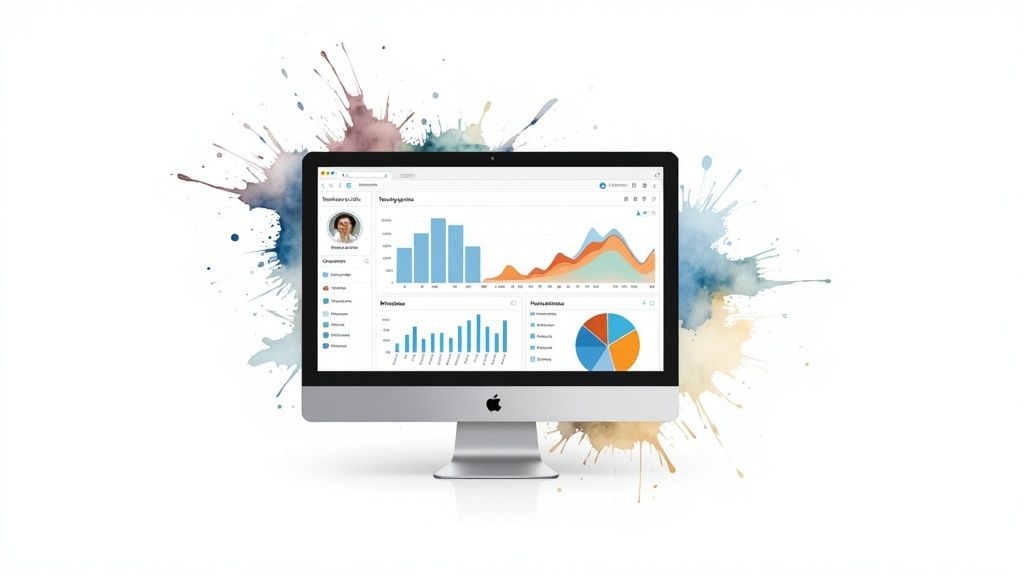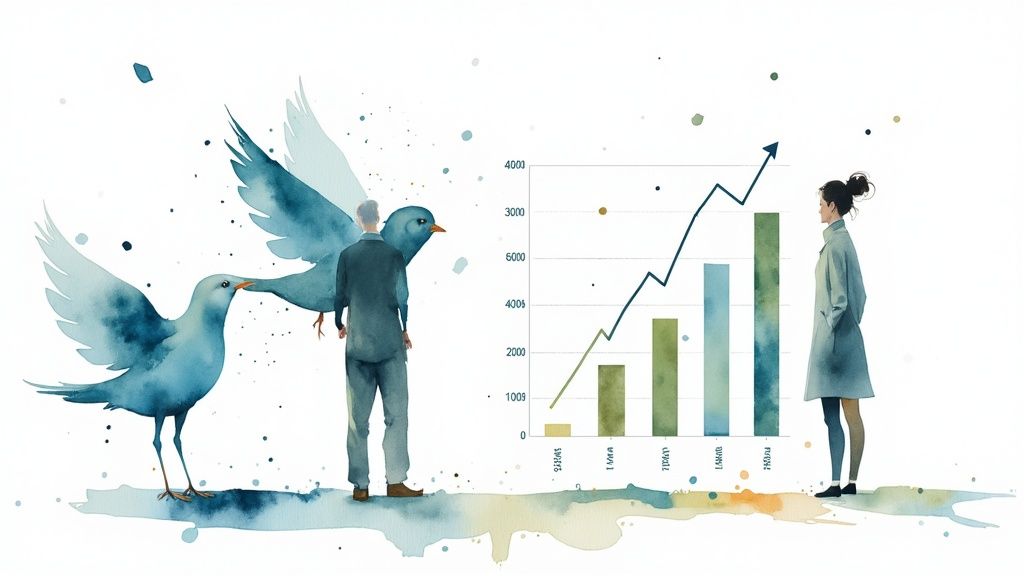




Twitter analytics isn't simply a collection of numbers; it's a crucial tool for understanding your audience and refining your Twitter strategy. By effectively using these analytics, you can shift from reactive posting to proactive communication, optimizing your content for maximum impact. This section explores the core components of Twitter analytics and emphasizes their importance for success on the platform.
Effective Twitter analysis begins with understanding the key metrics that drive meaningful results. Impressions represent the total number of times your tweets are displayed, providing a measure of your content's reach. Engagements, on the other hand, measure interactions like likes, retweets, replies, and link clicks, indicating audience interest and participation. Finally, Profile Visits track how many times users view your profile, suggesting a deeper level of interest in your brand or content.
Analyzing these metrics in conjunction provides valuable insights. For example, a high number of impressions combined with low engagement may indicate that your content isn't resonating. Conversely, a significant number of profile visits suggests genuine interest in your brand, warranting further investigation into the user journey.
Knowing how to access and interpret your Twitter analytics is essential. Twitter’s built-in analytics dashboard offers basic insights into impressions, engagements, and audience demographics. However, this data is limited to the account owner and provides a relatively surface-level view.
For a more comprehensive analysis, including competitor benchmarking and historical data, third-party tools like Popsters are invaluable. These tools often provide features like sorting tweets by engagement metrics and analyzing follower growth over time, enabling a deeper understanding of performance trends. This granular data allows for more informed decisions about content strategy and campaign optimization.
Regularly reviewing your Twitter analytics isn't just best practice; it's a necessity for data-driven decision-making. Just as a business monitors its financial performance, you should consistently track your Twitter metrics to understand audience behavior and content effectiveness.
Consistent monitoring reveals what content resonates, what falls flat, and where opportunities for improvement lie. Whether your goal is growing your following, driving website traffic, or building brand awareness, regular analytics checks provide the insights needed to achieve your objectives. This foundational understanding sets the stage for more advanced analytical techniques, which we'll explore later.

This guide provides a step-by-step approach to accessing Twitter analytics directly through the platform, whether you're on a desktop or mobile device. We'll also explore historical data access and troubleshooting common issues. Ultimately, this empowers you to efficiently leverage the data you need to refine your Twitter strategy.
Locating your analytics dashboard on desktop has become less straightforward due to recent platform updates. Begin by finding the "More" option in the left-hand menu of your Twitter profile page. Click "More" and then select "Creator Studio." Within Creator Studio, you'll find the "Analytics" option. This will direct you to your main analytics dashboard, the central hub for evaluating your Twitter performance.
The mobile process is similar, yet distinct. Tap your profile photo in the top-left corner. In the menu that appears, select "Professional Tools." The "Analytics" option will then be visible. Tapping this brings you to your analytics dashboard, providing convenient access to key metrics on the go.
The dashboard presents a summary of your Twitter performance. This overview provides valuable insights into content reach and audience engagement. Key metrics include impressions (how often your tweets were displayed), engagement rate, follower count, and total tweets posted. The updated analytics page also allows for side-by-side comparison of two metrics, enabling practical comparative analysis. Data can be viewed from the past week up to a full year, offering flexibility in analyzing short-term and long-term trends.
To better understand the various access methods, let's examine the following comparison:
Twitter Analytics Access Methods Comparison
This table compares different ways to access Twitter analytics across platforms.
| Access Method | Available Metrics | Limitations | Best For |
|---|---|---|---|
| Desktop (via Creator Studio) | Impressions, engagement rate, follower count, total tweets, etc. | Requires navigating through multiple menus | In-depth analysis and historical data review |
| Mobile (via Professional Tools) | Impressions, engagement rate, follower count, total tweets, etc. | May have slightly reduced functionality compared to desktop | Quick checks and on-the-go monitoring |
This table clearly illustrates the distinct paths for accessing your Twitter analytics depending on the platform used. While both provide essentially the same core metrics, the desktop version, accessed through Creator Studio, is generally better suited for deep dives and historical analysis. Mobile access, via Professional Tools, offers convenience for quick overviews and monitoring while on the move.
Historical data offers a wealth of insights that are often underutilized. Within the analytics dashboard, you can customize date ranges to analyze performance over specific timeframes. This allows for insightful comparisons and the identification of trends. Comparing performance across different marketing campaigns, for instance, can reveal valuable lessons about what resonates with your audience. This historical context is essential for refining your Twitter strategy.
Even experienced users occasionally face challenges accessing their Twitter analytics. One common issue is being redirected to the Twitter Ads interface. This often occurs if you've previously used Twitter's advertising platform. If this happens, look for a link or tab within the Ads interface that leads to the organic analytics dashboard. This typically resolves the redirect issue.

To effectively analyze your Twitter performance, you need to shift your focus from vanity metrics to those that genuinely impact your business goals. This means looking beyond follower counts and diving deeper into metrics that reflect real audience connection and account health. Understanding these key performance indicators (KPIs) is essential for optimizing your Twitter strategy and achieving meaningful results.
Engagement rate is arguably the most crucial metric on Twitter. It measures the level of active interaction your content receives from your audience. This goes beyond simple likes and retweets to encompass replies, quote tweets, link clicks, and media engagements. A high engagement rate suggests your content resonates with your audience, fostering conversation and building a strong community. Conversely, a low engagement rate, even with a large following, may indicate a disconnect and requires a reevaluation of your content strategy.
Impressions represent the number of times your tweets appear in users' timelines. This metric provides insights into the potential visibility of your content and how many people could have seen your tweets. Analyzing impressions helps you understand which content formats and topics generate the most visibility, informing future content creation. For instance, tweets with visually appealing media often garner more impressions, offering valuable feedback for optimizing your content strategy.
Monitoring follower growth is essential for gauging the overall health and trajectory of your Twitter presence. While not the sole indicator of success, consistent organic follower growth suggests increasing interest in your brand and content. A decline in followers, on the other hand, could signal potential issues with your messaging or content, prompting further investigation. For more insights into optimizing your Twitter strategy, check out this article on How to master Twitter trends and gather insights that drive results.
Understanding what constitutes "good" performance within your industry is critical for effective goal setting. Comparing your metrics against industry benchmarks offers valuable context, allowing you to identify areas for improvement and set realistic, achievable targets. Datareportal provides essential Twitter stats that can be useful for benchmarking. For example, as of April 2023, 64.3% of Twitter's advertising audience identified as male. Such demographic insights are crucial for tailoring your content strategy and maximizing targeting effectiveness.
The following table provides a breakdown of key Twitter metrics:
Critical Twitter Metrics Explained A comprehensive breakdown of key Twitter metrics and what they mean for your strategy
| Metric | Definition | Why It Matters | Target Benchmarks |
|---|---|---|---|
| Engagement Rate | Percentage of users who interact with your content (likes, retweets, replies, etc.) | Shows how well your content resonates with your audience. | Varies by industry, aim for above average. |
| Impressions | Number of times your tweets appear in users' timelines. | Indicates the potential reach of your content. | Track trends and aim for consistent growth. |
| Follower Growth | Rate at which your follower count increases. | Reflects growing interest in your brand and content. | Aim for steady organic growth. |
This table summarizes the key metrics you should be tracking to effectively evaluate your Twitter performance. By understanding these metrics and comparing them against industry benchmarks, you can gain valuable insights and refine your strategy for optimal results.
Ultimately, demonstrating the return on investment (ROI) of your Twitter efforts requires connecting your Twitter activity to tangible business outcomes. This involves linking metrics like website clicks, lead generation, and conversions directly to your Twitter activity. By showcasing the impact of your Twitter strategy on measurable business results, you can justify continued investment and secure stakeholder buy-in. This emphasizes the importance of shifting away from vanity metrics and concentrating on actionable results.

While Twitter's native analytics provides a solid foundation for understanding performance, it offers a limited view. To truly maximize the potential of your Twitter data and achieve a competitive advantage, exploring external resources is essential. This involves delving into the realm of third-party Twitter analytics platforms.
These tools offer advanced features and more comprehensive insights that can significantly enhance your Twitter strategy.
Basic metrics are provided by native analytics, but they frequently lack the depth required for strategic decision-making. For instance, you might see your total impressions, but identifying specific demographics engaging with your content or understanding the sentiment surrounding particular tweets becomes challenging. This is precisely where the value of third-party tools emerges.
They offer more granular data and specialized features to uncover hidden patterns and trends. This empowers you to move beyond simply reviewing Twitter analytics to gain a true understanding of your audience and optimize your content strategy.
A number of robust third-party platforms offer powerful Twitter analytics capabilities. Among the most popular are Hootsuite, Buffer, Sprout Social, and Popsters. Each platform provides a distinct set of features and functionalities.
Hootsuite: Known for its comprehensive social media management capabilities, Hootsuite offers robust analytics, including detailed reports on engagement, reach, and follower growth.
Buffer: Similar to Hootsuite, Buffer excels at scheduling and publishing content. It also delivers insightful analytics on post performance and audience demographics.
Sprout Social: This platform focuses on social listening and engagement, with analytics features designed to interpret audience sentiment and identify key influencers.
Popsters: Popsters specializes in content analysis, enabling you to track the performance of various content formats and pinpoint top-performing posts.
Third-party tools can reveal invaluable insights into your competitors' Twitter activity. Analyzing their posting frequency, content themes, and audience engagement can uncover opportunities to differentiate your own strategy.
Moreover, these tools often include sentiment analysis features. This allows you to gauge public opinion on specific topics and adapt your messaging accordingly.
For advanced text analysis, tools like WordStat are particularly effective. WordStat facilitates the automated categorization of tweets, using dictionaries or machine learning. This enables analysis of large volumes of Twitter data to identify trends, assess sentiment, or track specific keywords. Explore this further in the WordStat PDF Document. This granular level of analysis provides a deeper understanding of audience preferences, facilitating targeted content creation.
Integrating third-party tools into your workflow can streamline your analytics process. Many platforms offer customized reporting features, enabling seamless data sharing with stakeholders and demonstrating the effectiveness of your Twitter strategy.
Additionally, many tools incorporate AI-powered features. These features provide data-driven recommendations for optimizing content, scheduling posts, and identifying trending topics. This foresight allows you to anticipate changes in audience behavior and maintain a competitive edge.
The best tool for you depends on your specific goals, team size, and budget. By carefully evaluating your needs and exploring the available options, you can harness the full potential of third-party analytics to elevate your Twitter performance.
Understanding your Twitter audience is much more than simply knowing your follower count. To truly connect and optimize your content strategy, you need to understand who these followers are. This involves analyzing demographics, understanding their interests, and identifying their active hours. This section explores how to access and interpret this crucial information.
Twitter Analytics provides a starting point for understanding your audience. The "Audience" tab within the "Analytics" section offers basic demographic data, including your followers' location, gender, and interests. Accessing this data is relatively straightforward, but realizing its strategic implications requires deeper analysis.
Knowing your followers' locations offers strategic advantages. A concentration of followers in a specific city or region, for example, allows you to tailor content to that local audience. This might involve referencing local events, news, or cultural trends. Location insights can also inform targeted advertising campaigns, maximizing impact. This is particularly valuable for local crypto investors seeking insights for local initiatives.
Understanding your audience's gender distribution can influence messaging and content. While avoiding stereotypes is crucial, recognizing trends in gender preferences can help you fine-tune your communication style and content themes. For example, a predominantly male audience interested in specific altcoins may respond better to technical discussions and investment analysis than broader lifestyle content.
Identifying your followers' interests is crucial for shaping content strategy. By analyzing these interests, you can create content directly aligned with their preferences. If a significant portion of your audience is interested in Decentralized Finance (DeFi) or a particular cryptocurrency, creating targeted content on those topics maximizes relevance. This leads to higher engagement and a stronger connection with your followers. For Coindive users, understanding these interests can also help tailor notifications on sentiment, new content, and major announcements, creating a seamless user experience.
Analyzing when your followers are most active on Twitter is key for maximizing visibility. Posting when your audience is offline reduces your content's reach. Tailoring your posting schedule to their active hours significantly increases engagement. This optimization ensures maximum reach, potentially driving more traffic to platforms like Coindive. This data, readily available within Twitter analytics, provides a clear pathway for strategically timing your posts.
The difference between average and exceptional Twitter accounts isn't access to data—it's how they use it. This section provides a framework for turning Twitter analytics insights into concrete improvements for your strategy. You'll learn how successful accounts leverage data for continuous refinement and measurable growth.
How do you know what truly resonates with your Twitter audience? Analytics provides the answer. By regularly checking your Twitter analytics, you can identify your highest-performing content types. Look for patterns in engagement metrics.
Are image tweets consistently outperforming text-based updates? Do videos generate more replies and retweets? These insights are gold. For example, if you find that tweets featuring insightful questions receive significantly more engagement, incorporate this format into your future content calendar.
This data-driven approach ensures you're consistently delivering content that captivates your target audience.
Numbers tell a story. Digging deeper into Twitter analytics reveals the psychological triggers driving engagement. Why does one type of content outperform another? What motivates your audience to like, retweet, or reply?
Consider the emotional tone of your successful tweets. Are they humorous, inspirational, or informative? Additionally, analyze the language used in your most engaging tweets. This reveals what kind of vocabulary resonates with your audience.
By understanding the "why" behind your audience's actions, you can create even more compelling content. This leads into the next critical element: testing.
Data-driven decision-making relies on testing. Twitter analytics makes it easy to track the impact of different strategies. Try varying your posting times, content formats, and call-to-actions. Monitor the corresponding changes in your engagement metrics.
Did posting at a different time increase impressions or reach? Did a change in your hashtag strategy influence engagement? This iterative process, much like A/B testing in marketing, enables continuous refinement.
You can continually improve your results by regularly checking your Twitter analytics and making adjustments based on the data. This ensures your strategy remains dynamic and responsive to your audience's evolving preferences.
Examining real-world successes demonstrates the power of data-driven decision-making. Many accounts have dramatically improved their performance by making strategic pivots based on analytics insights. For instance, a brand might discover through Twitter analytics that a specific segment of their audience is highly engaged with content related to a niche topic they hadn't previously focused on.
By shifting their content strategy to cater to this discovered interest, the brand could see a significant increase in engagement, follower growth, and overall reach. These tangible results underscore the importance of translating numbers into strategic actions.
Data loses its value if it sits idle. Develop a routine for reviewing your Twitter analytics. Whether it's weekly or monthly, consistent check-ins are vital. More importantly, pair these reviews with action plans.
Don't just observe trends. Translate them into concrete changes in your content strategy, posting schedule, or engagement tactics. This active approach ensures that analytics data becomes a driver of growth, not just a passive observation.
By checking Twitter analytics regularly and implementing the insights gained, you can transform your Twitter presence from a reactive platform into a powerful engine for growth and engagement.
Want to streamline your crypto investment journey and enhance your understanding of market sentiment, social trends, and project performance? Explore Coindive today and discover the power of informed crypto decisions.